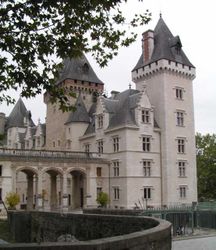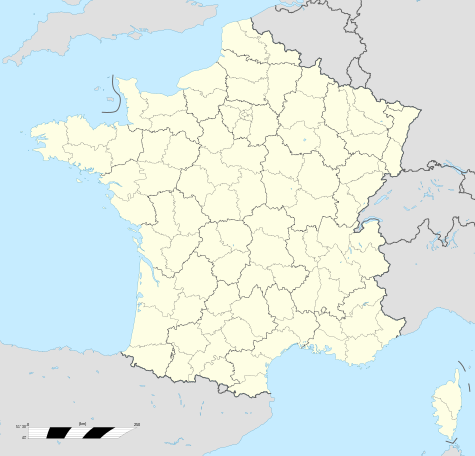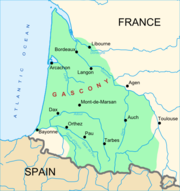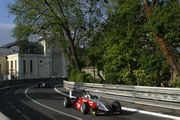Pau, Pyrénées-Atlantiques
|
Pau |
|
 |
|
| Château de Pau | |
 |
|
| Coat of arms | |
 Pau
|
|
| Administration | |
|---|---|
| Country | France |
| Region | Aquitaine |
| Department | Pyrénées-Atlantiques |
| Arrondissement | Pau |
| Intercommunality | Pau Pyrénées |
| Mayor | Martine Lignières-Cassou (PS) (2008–2014) |
| Statistics | |
| Elevation | 165–245 m (541–804 ft) (avg. 178 m/584 ft) |
| Land area1 | 31.51 km2 (12.17 sq mi) |
| Population2 | 84,978 (2007) |
| - Density | 2,697 /km2 (6,990 /sq mi) |
| INSEE/Postal code | 64445/ 64000 |
| 1 French Land Register data, which excludes lakes, ponds, glaciers > 1 km² (0.386 sq mi or 247 acres) and river estuaries. | |
| 2 Population sans doubles comptes: residents of multiple communes (e.g., students and military personnel) only counted once. | |



Pau is a commune on the northern edge of the Pyrenees, capital of the Pyrénées-Atlantiques département in France. It was also the capital of the Béarn region. It forms the communauté d'agglomération of Pau-Pyrénées with 13 neighbouring communes to carry out local tasks together. The Université de Pau et des Pays de l'Adour, founded in 1972, means there is a high student population. The Boulevard des Pyrénées is 1.8 km from the Château de Pau to the Parc du Beaumont, with views of the mountains. Alphonse de Lamartine said: "Pau has the world's most beautiful view of the earth just as Naples has the most beautiful view of the sea."
Contents |
Origin of name
The origin of the name is uncertain. One tradition suggests it is a corruption of pal, from the palings around the original château. Another is that the name refers to a ford across the river administered by the church, the pious. More recent research suggests the pre-Indo-European word for a rockface was pal or bal and that the name refers to Pau's position at the foot of the mountains. The name of the town appeared in the 12th century. The inhabitants of the city are known as palois. Their motto is Urbis palladium et gentis.
Geography
Pau is 100 km from the Atlantic Ocean and 50 km from the Pyrenees. Spain is 50 km away in a straight line. The frontier is crossed by the col du Somport (1,631 m) and the col du Pourtalet (1,794 m). Access to the crossings partly accounts for Pau's strategic importance. The city stands on a 200m elevation overlooking the valley of a mountain river called the Gave de Pau, where a ford gave passage to the Pyrenees. The Gave, which becomes a torrent when mountain snow melts, begins in the Cirque de Gavarnie. It is the principal tributuary of the Adour after 175 km. The crossing was used for pasturage of sheep in the high meadows. The old route is now a hiking path, GR 65, that runs 60 km south to the border.
The other rivers of the region are the Luy de Béarn, tributary of the Luy, the Ousse, and the Ousse des Bois, which flow into the Gave de Pau, and the Uzan, which joins the Luy de Béarn.
Pau is located 200 km west of Toulouse, 30 km from Tarbes and Lourdes, 25 km from Oloron. The conglomeration of Bayonne-Anglet-Biarritz is at 110 km, Bordeaux 190 km. Pau is served by the airport of Pau-Pyrénées 10 km away. There are limited scheduled flights to Amsterdam, Bristol, Brussels, London, Lyon and Paris.
A TGV rail line on the line to Paris and from Bayonne to Tolouse, and the A64 autoroute to the east. The A65, due for completion in 2010, will link Pau with Bordeaux.
The Funiculaire de Pau links the city centre and Boulevard des Pyrénées to the railway station in the valley. The Société des Transports de l'Agglomération Paloise (STAP) operates 13 urban bus routes, serving Pau and the adjoining communes.
History
The site was fortified in the 11th century [1] to control the ford across the Gave de Pau. It was built on the north bank, equi-distant from Lescar, seat of the bishops, and from Morlaàs, and became the seat of the viscounts of Béarn. Pau was made capital of Béarn in 1464. During the early 16th century, the Château de Pau, made more habitable by Gaston III, count of Foix, became the residence of the kings of Navarre, who were also viscounts of Béarn.
In 1188, Gaston VI assembled his cour majour there, predecessor of the conseil souverain and roughly equivalent to the House of Lords (but predating it). Gaston VII added a third tower in the 13th century. Gaston Fébus (Gaston III of Foix and Gaston X of Béarn) added a brick dungeon.
Pau was birthplace of Henry IV of France. His mother, Jeanne d'Albret, crossed France to ensure her son would be born there. The baby's lips were moistened with the local Jurançon wine and rubbed with garlic shortly after birth. When Henry IV left Pau to become King of France, he remarked to local notables that he was not giving Béarn to France but giving France to Béarn.
Napoleon III refurbished the château and Pau added streets of Belle Époque architecture, before fashion transferred to Biarritz. Pau is still a centre for winter sports and equestrian events, with a steeplechase. Charles XIV of Sweden was born in Pau, in 1763.
Bernadotte was born in the town of Pau, in the province of Béarn, France.
As the Crown Prince of Sweden he assumed the name Karl Johan (Charles John), acted officially as regent for the remainder of Charles XIII's reign and secured a forced personal union between Sweden and Norway in the 1814 Campaign against Norway. Jean-Baptiste Bernadotte reigned as King Charles XIV of Sweden and Carl III Johan of Norway from 5 February 1818 until his death on 8 March 1844.
The House of Bernadotte reigned in both countries until the dissolution of the union between Norway and Sweden in 1905. Prince Carl of Denmark, a grandson of King Charles XV, was then elected as Norway's new king.
The coat of arms of the House of Bernadotte combines the coat of arms of the House of Vasa (heraldic left) and the coat of arms of Bernadotte as the Prince of Ponte Corvo (heraldic right). It is visible as an inescutcheon in the Greater Coat of Arms of the Realm.
The original home of Bernadotte in the center of Pau - where he lived prior to moving to Sweden - has been maintained in good condition. It is open for daily visits by the general public.
Main sights
In the centre of Pau is a large castle, the Château de Pau, that dominates that quarter of the city. It is famous for being the birthplace of the 16th century king of France Henry IV and was once used by Napoleon as a holiday home during his period of power. It has a small garden that was tended by Marie Antoinette when she spent much of the summers in the city. The château now is considered a French historical monument and contains a nice collection of tapestry.
Economy
From the 1950s to the 1990s Pau depended on the production of natural gas and sulphur dioxide which were discovered nearby at Lacq. Today the mainstays of the Béarn area are the oil business, the aerospace industry through the helicopter turboshaft engines manufacturer Turbomeca, tourism and agriculture. Pau was the birthplace of Elf Aquitaine, which has now become a part of Total. Halliburton has an office in Pau.[2]
Transporation
The train station Gare de Pau offers connections to Bordeaux, Bayonne, Toulouse and Paris, and several regional destinations. Public transport within the city is available from the bus system: IDELIS.
British tourism
The British discovered Pau and its climate and left their imprint, partly because Wellington left a garrison there in 1814 after defeating Marshal Soult at Orthez (some 40 km to the NW) on his way into France from Spain towards the end of the Peninsular War. Vacationing British began arriving before the railway established the Boulevard des Pyrenées, the first full 18-hole golf course in Europe - laid out in 1856-1860, and still in existence - and a real tennis court. The Galway Irish Pub on the Boulevard des Pyrenées is one of the more popular bars in the town. Famous Irish people such as Liam Neeson, Pierce Brosnan and David Tracey have been known to have frequented the town.
Military presence
During the last two years of the World War (1917–1918), Pau was the home to the School of Acrobacy and Combat for French, British and American aviators.
Pau is the home of the French military's Ecole des troupes aéroportées, which trains and certifies military paratroops.
Sport
The local basketball team, Élan Béarnais Pau-Orthez have been French champions five times in the last ten years- most recently in 2004. Famous former players include Boris Diaw, Mickael Pietrus and Johan Petro.
Pau is home to Section Paloise, the city's rugby union team, which plays in the second French division known as Pro D2. Most recently in 2000, it won the European Challenge Cup, a top European trophy. French International player Damien Traille once played for the team and is a native to the city. The city also has a football (soccer) team, Pau FC which is in the fourth division called "CFA".
Pau is home to the first golf course on continental Europe, laid out in 1856. Since May 2007, the converted trinquet has reopened to its original sport, real tennis, on Sundays.
Since 1930, Pau has become a mainstay of the Tour de France cycling race, thanks both to its geographical location and to its marvelous infrastructure. Pau hosted its 63nd stage in 2010, and only one other city besides Paris has done better. In 2010 it will be passed on three occasions; first as a passing town, second time as a finish, and the third time as a departure town on the way to the Col du Tourmalet.
In 2008, between August 11–23, Pau hosted the 83rd French Chess Championship. The men's event was won by Étienne Bacrot, on tie-break from Maxime Vachier-Lagrave, while the women's event resulted in a victory for Sophie Milliet. Thirty-six players took part. Pau was previously the Championship venue in 1943 and 1969.
For amateur joggers the Gave de Pau river banks footpath is a most valued itinerary, which starts near the castle and passes along Pau's golf course heading west. Another spot is Pont-Long wood north of the town.
Pau Grand Prix
Pau held the first race to be called a Grand Prix in 1901. After that the 1928 French Grand Prix was held in nearby Saint-Gaudens, Pau also wanted to arrange the race and in 1930 the French Grand Prix was held on a Le Mans-type track outside the city with Philippe Étancelin winning for Bugatti. Pau returned to the calendar in 1933 with a track in centre inspired by Monaco.
The track, 2.769 km long, is winding and has remained largely unchanged. The first curve is the station hairpin. After that the road climbs on the Avenue Léon Say, alongside the stone viaduct that carries the Boulevard de Pyrenées, to Pont Oscar. A tunnel is followed by the narrow hairpin at the Louis Barthou high school that leads the track into the demanding Parc Beaumont section at the top of the town. After the Casino garden and another hairpin, the track winds back to the start along the Avenue Lacoste.
Pau traditionally opened the season but mid-February for the 1933 GP meant the race took place in a snowstorm with sludge. After a one year pause the race was back in 1935 with Tazio Nuvolari dominating in an Alfa Romeo P3 entered by Scuderia Ferrari. The 1936 race saw the only major victory for the Maserati V8-R1, driven by Ètancelin. In 1937 the race was part of the French sports car series with Jean-Pierre Wimille dominating, running three to four seconds a lap faster than the rest of the field. GP racing was back in 1938 and Pau became a test track for Mercedes-Benz before the Grandes Epreuves.
The 1938 race saw René Dreyfus' Delahaye sensationally beating the Mercedes-Benz team. In 1939 Mercedes wasn't to be taken by surprise, Hermann Lang leading the team to a double victory. After the war Pau continued as a non-championship Formula One race until 1963. Thereafter the race was run to Formula Two rules until the sport was replaced by Formula 3000 in 1985. In 1999, the event again changed, with Formula Three cars racing. Finally, in 2007, the race became a round of the World Touring Car Championship.
Births
Pau was the birthplace of:
- Gastón de Peralta, marqués de Falces (1510–1587), viceroy of New Spain from 1566 to 1568
- Jeanne d'Albret (1528–1572), Queen of Navarre from 1555 to 1572
- Henry IV (1553–1610), king of France from 1589 to 1610
- Jean-Baptiste Jules Bernadotte (1763–1844), Marshal of France and later King of Sweden and Norway
- Charles Denis Bourbaki (1816–1897), French general of Greek descent
- Nuno Maria José Caetano Álvares Pereira de Melo (1888–1935), 9th duke of Cadaval
- Jean Jules Verdenal (1890–1915), friend and correspondent of T. S. Eliot
- Marguerite Broquedis (1893–1983), tennis player
- André Courrèges (born 1923), fashion designer
- Roger-Gérard Schwartzenberg (born 1943), politician
- Alain Lamassoure (born 1944), politician
- Francis Lassus (born 1961), musician
- Bertrand Cantat (born 1964), singer and songwriter
- Walter Lapeyre (born 1976), pistol shooter
- Nicolas Cazalé (born 1977), actor and model
- Edouard Cisse (born 1978), footballer
- Tony Estanguet (born 1978), slalom canoer
- Cédric Gracia (born 1978), mountain biker
- Jean-Baptiste Peyras-Loustalet (born 1984), rugby union player
- Jérémy Chardy (born 1987), professional tennis player
Twin towns
Pau has been twinned with
|
See also
- Pau FC
- Palais des Sports de Pau
- Stade du Hameau
- CSTJF
- Communes of the Pyrénées-Atlantiques department
- Saint-Cricq High School
References
- ↑ Histoire de Pau, pp. 11-15
- ↑ "Office Location." Halliburton. Retrieved on 13 January 2009.
- ↑ "Regional Overview". MobileChamber.com. http://www.mobilechamber.com/regionaloverview.pdf. Retrieved 2007-10-15.
External links
- Tourist office of the city (English)
- City council website (French)
- "Pau and around: Pau tourism travel guide" (English)
- Pau's Chinese Community Website
- Google Map of Pau
|
|||||